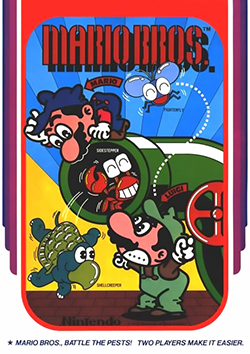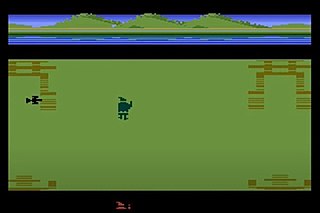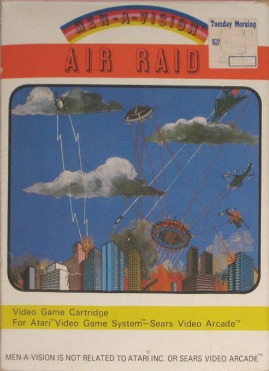
The Atari 2600 is a home video game console developed and produced by Atari, Inc. Released in September 1977, it popularized microprocessor-based hardware and games stored on swappable ROM cartridges, a format first used with the Fairchild Channel F in 1976. Branded as the Atari Video Computer System from its release until November 1982, the VCS was bundled with two joystick controllers, a conjoined pair of paddle controllers, and a game cartridge—initially Combat and later Pac-Man.

Mario Bros. is a platform game developed and published by Nintendo as an arcade video game in 1983. It was designed by Shigeru Miyamoto and Gunpei Yokoi, Nintendo's chief engineer. Italian twin brother plumbers Mario and Luigi exterminate creatures emerging from the sewers by knocking them upside-down and kicking them away. The Famicom/Nintendo Entertainment System version is the first game produced by Intelligent Systems. It is part of the Mario franchise, but originally began as a spin-off from the Donkey Kong series.

E.T. the Extra-Terrestrial is a 1982 adventure video game developed and published by Atari, Inc. for the Atari 2600 and based on the film of the same name. The game's objective is to guide the eponymous character through various screens to collect three pieces of an interplanetary telephone that will allow him to contact his home planet.

Adventure is a video game developed by Warren Robinett for the Atari Video Computer System and released in 1980 by Atari, Inc. The player controls a square avatar whose quest is to explore an open-ended environment to find a magical chalice and return it to the golden castle. The game world is populated by roaming enemies: three dragons that can eat the avatar and a bat that randomly steals and hides items around the game world. Adventure introduced new elements to console games, including enemies that continue to move when offscreen.

Pitfall! is a video game developed by David Crane for the Atari Video Computer System and released in 1982 by Activision. The player controls Pitfall Harry, who has a time limit of 20 minutes to seek treasure in a jungle. The game world is populated by enemies and hazards that variously cause the player to lose lives or points.
Star Wars: Return of the Jedi: Ewok Adventure, also known as Revenge of the Jedi: Game I, is a cancelled 1983 shoot 'em up video game based on the 1983 Star Wars film Return of the Jedi. The game was developed by Atari Games and was to be published by Parker Brothers on the Atari 2600. Although it was completed, the game was never released for sale, as the marketing department of Parker Brothers considered the controls too difficult to master. A prototype cartridge surfaced in 1997.

In the history of video games, the second-generation era refers to computer and video games, video game consoles, and handheld video game consoles available from 1976 to 1992. Notable platforms of the second generation include the Fairchild Channel F, Atari 2600, Intellivision, Odyssey 2, and ColecoVision. The generation began in November 1976 with the release of the Fairchild Channel F. This was followed by the Atari 2600 in 1977, Magnavox Odyssey² in 1978, Intellivision in 1980 and then the Emerson Arcadia 2001, ColecoVision, Atari 5200, and Vectrex, all in 1982. By the end of the era, there were over 15 different consoles. It coincided with, and was partly fuelled by, the golden age of arcade video games. This peak era of popularity and innovation for the medium resulted in many games for second generation home consoles being ports of arcade games. Space Invaders, the first "killer app" arcade game to be ported, was released in 1980 for the Atari 2600, though earlier Atari-published arcade games were ported to the 2600 previously. Coleco packaged Nintendo's Donkey Kong with the ColecoVision when it was released in August 1982.

Pepsi Invaders is a non-commercially released 1983 fixed shooter video game developed by Atari, Inc. for the Atari 2600. It was commissioned by The Coca-Cola Company to be handed out to salespeople at their 1983 sales convention. A reskin of the system's version of Space Invaders, the player shoots down a flying formation of letters spelling "PEPSI", Coca-Cola's long-time rival. Only 125 copies were distributed.
Video game collecting is the hobby of collecting and preserving video games, video game consoles, and related memorabilia. Most video game consoles, and their games, are considered to be collectors' items years after their discontinuation due to their functional longevity and cultural significance. Collectors usually narrow their search to games holding characteristics they enjoy, such as being published for a specific video game console, being of certain genre, or featuring a specific character.
Christian video games are a video game genre and a form of Christian media that focus on the narrative and themes of Christian morals and Christianity. The term can also refer to Christian symbolism, mythology, media franchises, and Christian media organizations within video game culture and industry.

Pac-Man is a 1982 maze video game developed and published by Atari, Inc. under official license by Namco, and an adaptation of the 1980 hit arcade game of the same name. The player controls the title character, who attempts to consume all of the wafers while avoiding four ghosts that pursue him. Eating flashing wafers at the corners of the screen will cause the ghosts to turn temporarily blue and flee, allowing Pac-Man to eat them for bonus points.

The Lord of the Rings: Journey to Rivendell was a video game scheduled to be released in the winter of 1983. Parker Brothers was set to publish it, and advertised it in their 1982 and 1983 catalogues as a game that would be released on the Atari 2600 and Atari Home Computer. The game was originally advertised under the name Lord of the Rings, and in one case as The Lord of the Rings I. It was described as an adventure of getting Frodo from the Shire to the door at Moria, a description which was later changed in the 1983 Parker Brothers Video Games catalogue to have Rivendell as the adventures end point instead. The same catalogue was first time the game was ever referred to as The Lord of the Rings: Journey to Rivendell, and was the last advertisement the game ever received. The game was never released, and it was believed that little or no work was done on the game's coding.

Air Raid is a 1982 shoot 'em up published for the Atari 2600 by Men-A-Vision, the only game released by the company. The cartridge is a blue T-handle design with a picture of flying saucers attacking a futuristic city. It had extremely limited distribution, making it highly sought after by video game collectors.

The Atari video game burial was a mass burial of unsold video game cartridges, consoles, and computers in a New Mexico landfill site, undertaken by the American video game and home computer company Atari, Inc. in 1983. Before 2014, the goods buried were rumored to be unsold copies of E.T. the Extra-Terrestrial (1982), one of the largest commercial video game failures and often cited as one of the worst video games ever released, and the 1982 Atari 2600 port of Pac-Man, which was commercially successful but critically maligned.
Games by Apollo Inc. was a third-party developer of games for the Atari 2600 video game system, based in Richardson, Texas. It was founded in October 1981 by Pat Roper as a subsidiary of his National Career Consultants (NCC). Apollo's first title was Skeet Shoot, and neither it nor the ten games that followed caught on, and the company was one of the first to declare bankruptcy as a result of the video game crash of 1983.

The Atari 2600 hardware was based on the MOS Technology 6507 chip, offering a maximum resolution of 160 x 192 pixels (NTSC), 128 colors, 128 bytes of RAM with 4 KB on cartridges. The design experienced many makeovers and revisions during its 14-year production history, from the original "heavy sixer" to the Atari 2600 Jr. at the end. The system also has many controllers and third-party peripherals.

Tooth Protectors is a rare video game for the Atari 2600 video game console. It was released exclusively via mail order in 1983 by American pharmaceutical and consumer goods manufacturer Johnson & Johnson.

RealSports Baseball is a 1982 sports video game developed and published by Atari, Inc. originally for the Atari 2600. It was also launched on the Atari 5200 and 7800 machines. A version for the Atari 8-bit family of home computers was also in development, but it was cancelled.














